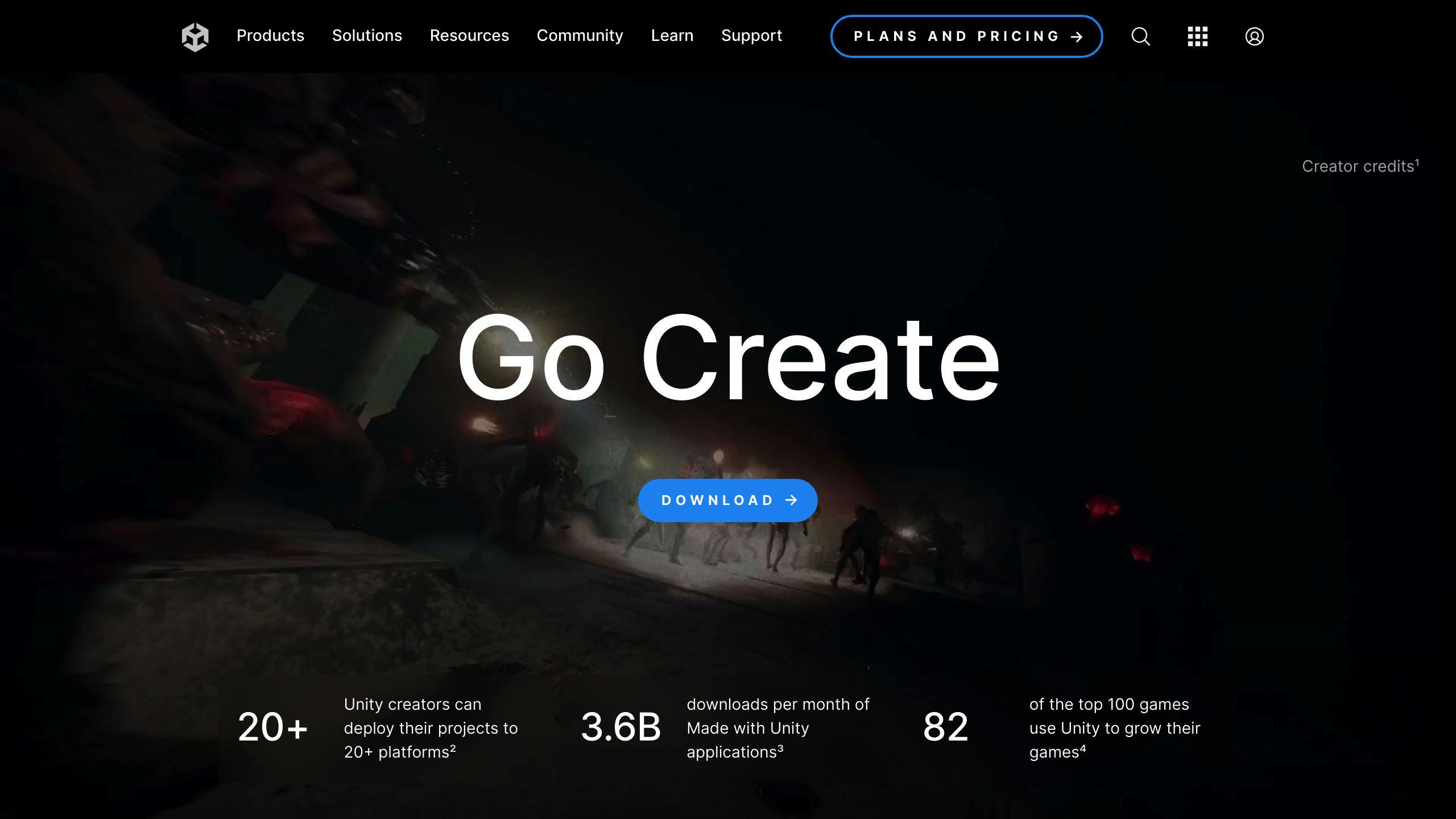Looking to build a tech career in 2025? Mastering the right programming languages is key. Here’s a quick overview of the top 10 languages driving the industry this year, based on demand, career opportunities, and relevance to emerging trends like AI, cloud computing, and mobile development:
- Python: Ideal for AI, data science, and web development. Easy to learn and widely used.
- JavaScript: The backbone of web and full-stack development. Essential for building dynamic web apps.
- Java: A reliable choice for enterprise applications and Android development.
- C++: Perfect for high-performance tasks like game engines and system-level programming.
- C#: Popular for game development (Unity) and enterprise software.
- Go (Golang): Great for scalable backend systems and cloud-native projects.
- Rust: Focuses on performance and safety, making it ideal for systems programming.
- TypeScript: Enhances JavaScript for large-scale applications with better maintainability.
- Swift: The go-to language for iOS and macOS app development.
- Kotlin: The preferred choice for modern Android development.
Quick Comparison Table
| Language | Best For | Learning Curve | Industry Demand | Salary Range* |
|---|---|---|---|---|
| Python | AI, Data Science, Web Dev | Easy | Very High | $95,000 – $140,000 |
| JavaScript | Web Development | Moderate | High | $90,000 – $135,000 |
| Java | Enterprise Apps, Android | Moderate-High | High | $85,000 – $145,000 |
| C++ | Game Dev, System Programming | High | Moderate-High | $95,000 – $150,000 |
| C# | Game Dev, Enterprise Apps | Moderate | High | $85,000 – $140,000 |
| Go | Cloud, Backend Systems | Moderate | Rising | $115,000 – $160,000 |
| Rust | Systems Programming | High | Rising | $120,000 – $170,000 |
| TypeScript | Scalable Web Apps | Moderate | High | $100,000 – $145,000 |
| Swift | iOS Development | Moderate | Moderate-High | $105,000 – $155,000 |
| Kotlin | Android Development | Moderate | Rising | $95,000 – $145,000 |
*Salary ranges are estimates based on industry data.
Focus on one or two languages based on your career goals, and complement them with real-world projects and tools. This guide will help you navigate the tech landscape and choose the right skills to stay competitive.
Top Programming Languages to Learn for High-paying Jobs
1. Python: A Go-To Language Across Industries
Python’s popularity shows no signs of slowing down in 2025, cementing its status as a key player in the tech world. From data science to web development, its influence spans multiple industries.
Why Python Stands Out
Python consistently ranks among the top five languages in the Stack Overflow Developer Survey. It’s a favorite for developers and a must-have tool for major companies like Google, Meta, and Netflix.
What Makes Python Powerful
Python combines simplicity with flexibility. Its clean syntax makes it easy to learn and use, while its support for both object-oriented and functional programming makes it adaptable for various projects.
Where Python Shines
Python’s flexibility is evident in its wide-ranging applications:
| Industry Sector | Applications | Tools/Frameworks |
|---|---|---|
| Data Science & Finance | Analytics, Risk Analysis, Automation | NumPy, pandas, QuantLib |
| AI/ML | Machine Learning, Neural Networks | TensorFlow, PyTorch |
| Web Development | Backend Services, APIs | Django, Flask |
Learning and Community Resources
Python’s official documentation, along with resources from platforms like Django and TensorFlow, offers clear paths for learning. Whether you’re a beginner or aiming for a specialized role, there’s plenty of guidance available.
Career Opportunities
The demand for Python developers is growing, especially in fields like machine learning and data engineering, where salaries are highly competitive. Learning Python not only opens doors to various industries but also keeps you prepared for future trends.
While Python dominates with its wide applications, JavaScript continues to lead the charge in web development, shaping the future of front-end and full-stack technologies.
2. JavaScript: The Backbone of Web Development
JavaScript continues to dominate as the go-to programming language for web development in 2025. Its ability to handle both front-end and back-end tasks makes it a must-have skill for developers today.
Industry Impact and Demand
JavaScript developers are in constant demand, with major players like Google, Facebook, and Netflix depending on it for their web platforms. Once seen as a simple client-side scripting tool, JavaScript has evolved into a full-stack development powerhouse.
Core Strengths and Applications
JavaScript is key to creating dynamic and interactive web experiences. Different industries use it in various ways:
| Sector | Applications | Popular Tools |
|---|---|---|
| Front-end Development | Interactive UIs, Single Page Apps | React, Angular, Vue.js |
| Back-end Development | Server-side Applications, APIs | Node.js, Express |
| Mobile Development | Cross-platform Apps | React Native, Ionic |
| Desktop Applications | Native-like Apps | Electron, NW.js |
Modern JavaScript Development
With tools like Node.js and frameworks such as React and Angular, JavaScript has reshaped how developers approach both server-side and front-end work. These advancements have made it easier to build scalable, efficient applications.
Learning Path and Resources
For those looking to master JavaScript, the following resources can help:
- Hands-on platforms like Codecademy and freeCodeCamp
- GitHub repositories with real-world projects
- Comprehensive documentation from Mozilla Developer Network (MDN)
Career Growth Opportunities
JavaScript opens doors to a wide range of roles, from front-end specialists to full-stack engineers. Its flexibility allows developers to build everything from responsive websites to mobile and desktop apps, making it a critical skill for career progression.
While JavaScript leads in web development, Java remains a strong contender for enterprise-level applications.
3. Java: A Reliable Choice for Enterprise Applications
Java continues to be a go-to technology for enterprise software development in 2025. Its history of managing critical applications makes it a must-know language for developers aiming to succeed in corporate settings.
Why Java Leads in Enterprise Software
Java stands out in enterprise software because it efficiently handles high-volume transactions and complex business needs. It’s widely used in industries such as:
- Banking: Secure and scalable transaction systems
- E-commerce: Platforms handling thousands of orders simultaneously
- Healthcare: Systems that ensure data accuracy for patient management
- Manufacturing: Software for managing resources and operations
Its cross-platform nature, strong security features, and vast library of tools make Java perfect for building scalable systems. On top of that, enterprise frameworks like Spring and Hibernate allow Java to process millions of transactions reliably in real-world settings.
How Java Is Used in Practice
From finance to healthcare, Java powers systems that manage enormous amounts of data daily. Its stability and performance make it the top choice for applications where uptime and secure data handling are non-negotiable.
How to Learn Java for Enterprise Development
To excel in Java, start with the basics and then dive into frameworks like Spring Boot and Hibernate. Work on projects that involve microservices, cloud deployments, and security to build practical expertise. Java’s widespread use in large organizations means it offers excellent career opportunities, especially for those focused on scalable and secure enterprise solutions.
While Java dominates enterprise software, C++ remains the preferred choice for systems where speed and control are critical. Both languages have their own strengths, making them valuable for different types of development work.
4. C++: A Go-To Language for Performance-Driven Development
C++ remains a cornerstone for developers working on high-performance applications and system-level programming in 2025. Its ability to offer direct hardware control and exceptional efficiency makes it indispensable for performance-critical tasks.
Where C++ Shines
C++ has carved a niche in industries that demand speed, precision, and control. Here’s how it stands out:
| Industry | Applications | Key Features |
|---|---|---|
| Game Development | High-performance engines, AAA games | Direct memory management |
| Financial Systems | Low-latency trading platforms | Multi-threading capabilities |
| Automotive Software | Real-time autonomous systems | Hardware-level control |
| Operating Systems | Core system components | Minimal processing overhead |
Advances in Modern C++
C++ has kept pace with modern development needs. Recent features like smart pointers and advanced containers have made programming more efficient and less error-prone, without losing the performance edge that developers rely on.
How to Learn C++
Want to master C++? Focus on these steps:
- Dive into foundational concepts with The C++ Programming Language by Bjarne Stroustrup.
- Experiment with modern features like smart pointers and memory management.
- Build performance-heavy projects using tools and libraries common in the industry.
Why C++ Matters for Your Career
C++ skills can open doors to industries where performance is non-negotiable. Whether it’s gaming, autonomous technologies, or financial systems, the demand for C++ experts is strong and growing.
While C++ continues to dominate system-level programming, languages like C# are gaining traction for developers seeking productivity in areas like high-performance gaming and enterprise applications.
5. C#: A Language Powering Game Development and Beyond
C# has become a go-to choice for game development and enterprise software, thanks to its integration with the .NET framework and its structured, strongly-typed approach. Developers value its ability to create scalable, high-performing applications, making it a key player in 2025.
Where C# Shines
C# is used across a variety of industries, offering unique advantages depending on the application:
| Industry Sector | Common Uses | Strengths |
|---|---|---|
| Game Development | Unity-based projects | Automatic memory management |
| Enterprise & Cloud | Azure, Microsoft Dynamics | Seamless .NET integration |
| Desktop Applications | Windows software | Optimized for Windows systems |
Why Developers Choose C#
C# boosts productivity with features like built-in memory management and deep integration with the .NET framework. These capabilities make it a great choice for resource-heavy projects without compromising developer efficiency.
Unity and Game Development

C# is the backbone of Unity, one of the most popular game engines. Whether you’re working on indie projects or large-scale AAA games, C# provides the tools and flexibility needed to bring ideas to life.
Getting Started with C#
Microsoft offers a wealth of resources to help new developers learn C#. Start with their official documentation and Visual Studio tutorials to grasp the basics, including syntax and object-oriented programming. From there, dive deeper into the .NET framework and focus on areas like game development or enterprise solutions.
Looking Ahead
As cloud computing and the .NET ecosystem continue to grow, C# remains a strong choice for developers. Learning C# not only opens doors in gaming and enterprise software but also positions you for opportunities in industries built around Microsoft’s expanding platforms.
While C# dominates in areas like game development and enterprise systems, languages like Go bring different strengths to building high-performance, scalable solutions.
6. Go (Golang): A Language for Scalable Systems
Go has become a go-to choice for building scalable, high-performance systems. Originally developed by Google, this language strikes a balance between the simplicity of interpreted languages and the efficiency of compiled ones, making it perfect for today’s software needs.
Industry Impact and Applications
Big names like Netflix and Google use Go to power their critical infrastructure, especially in cloud computing and distributed systems. A survey by the Go Foundation reveals that 71% of developers use Go for backend tasks, and 64% rely on it for cloud-native projects [3].
Core Strengths
| Feature | Advantage |
|---|---|
| Lightweight threads (goroutines) | Handles concurrent tasks efficiently |
| Built-in Testing | Simplifies development and upkeep |
| Static Typing | Improves code reliability |
| Standard Library | Speeds up development with ready-to-use tools |
Real-World Applications
Go is particularly strong in cloud-native and microservices development. Its efficient memory use, fast compilation, and built-in concurrency tools allow developers to create scalable and reliable systems without unnecessary complexity.
Learning Resources
The Go community offers plenty of support for learners. Beginners can start with the official Go Tour and move on to practical projects, taking advantage of detailed documentation and an active developer community.
Career Impact
With cloud computing continuing to grow, Go expertise opens doors to in-demand roles in backend and infrastructure development. Its increasing use by major companies makes it an excellent choice for developers focusing on scalable systems.
While Go is a strong contender for scalability and efficiency, Rust is gaining attention for its focus on performance and safety, positioning it as another key player in modern development.
sbb-itb-f454395
7. Rust: A Safe and Fast Language for Modern Development
Rust has become a standout choice for system-level programming, offering both speed and security. This makes it a go-to option for building software that demands high performance and reliability. As secure systems gain importance, Rust’s unique capabilities are shaping it into a critical tool for software development in the coming years.
Industry Impact and Adoption
Leading tech companies are turning to Rust for major infrastructure projects. Its ability to deliver reliable, high-performance systems has made it a preferred choice across various industries.
| Feature | How It Helps | Real-World Impact |
|---|---|---|
| Ownership System & Memory Safety | Eliminates programming errors and memory bugs | Fewer crashes, more stable applications |
| Efficient Abstractions & Concurrency | Offers advanced features without slowing down performance | Makes scalable, efficient programming possible |
Key Applications and Use Cases
Rust shines in areas where performance and reliability are non-negotiable, such as system programming, embedded systems, and game development. Its safety features combined with performance optimization make it ideal for building dependable, efficient systems.
Developer Resources and Learning Path
The official Rust documentation is a great place to start. Other resources like Rust by Example and Rustlings offer hands-on learning opportunities. Plus, Rust’s active community provides support through forums and chat platforms, helping developers navigate the learning process.
Career Prospects
Rust consistently ranks as one of the most loved programming languages, according to Stack Overflow’s Developer Survey [2]. Its focus on safety and performance makes it a sought-after skill, especially for roles in systems and infrastructure programming.
While Rust is a leader in system-level programming, TypeScript continues to dominate in modern web development, offering enhanced features for JavaScript developers.
8. TypeScript: A Stronger Version of JavaScript
TypeScript has become a go-to tool for developers building reliable and scalable applications. Created by Microsoft, this statically typed version of JavaScript is especially popular in enterprise settings and large-scale projects.
Why TypeScript Is in Demand
TypeScript is regularly featured in Stack Overflow’s Developer Survey as one of the most loved programming languages. Big names like Microsoft, Google, and Airbnb use it for major projects, citing improvements in code quality and easier long-term maintenance.
What Makes TypeScript Stand Out
TypeScript brings several advantages to the table, especially for teams working on complex projects:
- Better Development Tools: Static type checking combined with excellent IDE support ensures smarter code suggestions and early error detection.
- Advanced Programming Features: Includes interfaces, generics, and object-oriented patterns tailored for building complex applications.
Where TypeScript Shines
It’s particularly useful for large-scale web apps, enterprise systems, and team-based projects. The type system not only helps with error checking but also ensures compatibility with existing JavaScript, making it easier to integrate.
How to Get Started
You can dive into TypeScript using its official documentation or platforms like Udemy and Coursera. Tools like Visual Studio Code come with built-in support, allowing JavaScript developers to adopt TypeScript gradually without disrupting current workflows.
Boosting Your Career with TypeScript
As more companies prioritize code maintainability and collaboration, TypeScript has become a valuable skill. It’s especially sought after in organizations managing large codebases or focusing on scalable web development.
While TypeScript is transforming web development, Swift continues to dominate mobile app development.
9. Swift: The Go-To Language for iOS Development
Swift is the engine behind apps on iOS, macOS, watchOS, and tvOS. With Apple’s ecosystem running on over a billion active devices, there’s no shortage of demand for skilled Swift developers.
Why Swift Has Taken Off
Swift powers major iOS apps like Instagram and Uber. Its compatibility with tools like ARKit for augmented reality and Core ML for machine learning makes it essential for building advanced mobile apps. As Apple continues to push into AR and AI, Swift’s role in app development only grows stronger.
What Makes Swift Stand Out
Swift offers a mix of safety features, high-speed performance comparable to C++, and a modern syntax designed for Apple’s platforms. It works seamlessly with frameworks such as SwiftUI and Core Data, making it a great choice for:
- Building AR experiences with ARKit
- Developing machine learning models using Core ML
- Creating server-side apps with Vapor
- Designing enterprise-level iOS applications
Getting Started with Swift
Apple makes it easy to dive into Swift with tools like Swift Playgrounds, an interactive platform perfect for beginners. For more advanced users, the Swift Forums provide a space to connect with the developer community and find solutions.
The Job Market for Swift Developers
The growing iOS ecosystem keeps Swift skills in high demand. Areas where expertise is especially valuable include:
- SwiftUI for crafting modern user interfaces
- Core ML to integrate AI features
- ARKit for augmented reality projects
- Using Apple’s latest SDKs to stay ahead
Though Swift leads the way for iOS, Android developers find similar advantages with Kotlin’s modern, productivity-focused design.
10. Kotlin: A Modern Language for Android Development
Kotlin has been a game-changer for Android development since Google named it the preferred language in 2017. Big names like Pinterest and Coursera rely on Kotlin for their Android apps, showcasing its reliability for building large-scale projects.
Growing Popularity and Demand
Kotlin’s climb into the top 20 of the TIOBE Index highlights its increasing use and recognition [1]. Its compatibility with Java and adoption by leading companies make it one of the go-to languages for Android development in 2025. The demand for Kotlin developers has surged as more businesses embrace it as the backbone of their Android applications [2].
Features That Stand Out
Kotlin comes packed with tools that streamline Android development. Features like null safety help developers avoid runtime crashes, while coroutines simplify asynchronous tasks, making apps more efficient. Extension functions allow developers to add functionality without overcomplicating code, and smart casting eliminates unnecessary type checks, saving time and effort.
Practical Use Cases
Kotlin’s flexibility makes it ideal for a variety of applications:
| Application Type | Benefits |
|---|---|
| Data-Intensive Apps | Handles complex data processing efficiently |
| Enterprise Solutions | Provides a solid framework for large systems |
| Cross-Platform Mobile Apps | Delivers high performance with fewer crashes |
| Backend Services | Enables seamless cross-platform development |
Learning Resources and Career Opportunities
For those looking to master Kotlin, JetBrains offers detailed guides alongside Android-specific tutorials. The Android developer community is also a goldmine of resources, with official documentation and courses tailored to mobile development.
As mobile app usage continues to rise, Kotlin’s developer-friendly features make it an essential skill for building intuitive and reliable apps. With its growing popularity and strong support network, Kotlin stands out as a top choice for Android developers in 2025.
Comparison Table of Programming Languages
Here’s a quick look at some of the leading programming languages in 2025:
| Language | Type | Primary Use Cases | Industry Demand | Learning Curve | Notable Tools & Frameworks | Average Salary Range* |
|---|---|---|---|---|---|---|
| Python | Interpreted | Data Science, AI/ML, Web Development, Automation | Very High (+1.7% growth) | Easy | TensorFlow, Django, NumPy | $95,000 – $140,000 |
| JavaScript | Interpreted | Frontend Development, Full-stack Development | High | Moderate | React, Node.js, Vue.js | $90,000 – $135,000 |
| Java | Compiled | Enterprise Applications, Android Development | High | Moderate-High | Spring, Hibernate | $85,000 – $145,000 |
| C++ | Compiled | System Programming, Game Development | Moderate-High | High | Unreal Engine, Qt | $95,000 – $150,000 |
| C# | Compiled | Game Development, Windows Apps | High | Moderate | Unity, .NET Core | $85,000 – $140,000 |
| Go | Compiled | Cloud Infrastructure, Microservices | Rising | Moderate | Gin, Echo | $115,000 – $160,000 |
| Rust | Compiled | Systems Programming, WebAssembly | Rising | High | Rocket, Actix | $120,000 – $170,000 |
| TypeScript | Transpiled | Large-scale JavaScript Applications | High | Moderate | Angular, Next.js | $100,000 – $145,000 |
| Swift | Compiled | iOS Development | Moderate-High | Moderate | SwiftUI, Cocoa Touch | $105,000 – $155,000 |
| Kotlin | Compiled | Android Development | Rising | Moderate | Android SDK, Ktor | $95,000 – $145,000 |
*Salary ranges are based on data gathered from industry surveys and leading tech recruitment platforms [3].
Key Insights for Career Planning
Python continues to dominate with a 29.6% market share [3], especially in fields like AI and data science. Meanwhile, newer languages like Go and Rust are gaining traction in areas such as cloud infrastructure and systems programming, providing strong earning potential for those with expertise.
To build a successful career, consider these factors:
- Job market demand: Stay updated on which skills are most sought after.
- Relevance to your career goals: Choose languages aligned with your field.
- Learning resources: Look for platforms offering hands-on experience.
- Salary expectations: Evaluate compensation trends in your chosen area.
- Industry needs: Understand the tools and frameworks commonly used.
Focus on mastering one core language while developing a working knowledge of related technologies in your field. Platforms offering real-world project experience can help bridge the gap between learning and application.
These comparisons highlight how programming languages are shaping the tech industry in 2025.
Conclusion
As shown in the comparison table, programming languages today offer a wide range of opportunities across various industries. Choosing the right languages to learn is critical for building a successful tech career in 2025. Software development continues to change, with both established and newer languages taking on important roles in different areas.
Languages like Rust are gaining attention due to the growing focus on security, while Python remains a favorite for AI and automation. These trends highlight the need to stay updated with industry demands and technological progress.
Here are some strategies to help shape your tech career:
- Start with versatile languages and specialize: Learn widely-used languages like Python or JavaScript first. Then, focus on specialized tools like Rust for systems programming or Swift for iOS development based on your goals.
- Gain hands-on experience: Work on real-world projects and contribute to open-source communities to sharpen your skills.
- Stay connected with peers: Join developer communities to exchange ideas and keep up with the latest trends.
Remember, you don’t need to master every programming language. Instead, aim to build strong expertise in one or two main languages while staying familiar with related tools and technologies. This focused approach, paired with practical experience, can help you navigate the ever-changing tech world.
Using online resources and practicing regularly will bridge the gap between theory and application, giving you the tools needed to succeed. With a commitment to continuous learning, you’ll be ready to excel in the dynamic tech industry.
FAQs
As technology advances, developers often wonder which programming languages they should focus on to stay ahead. Here are answers to some of the most frequently asked questions.
Which programming language will be in demand in 2026?
Python is expected to remain a top choice through 2026, especially in areas like AI, data science, and web development. With over 108,000 job openings and usage by 31% of developers [4], Python is a must-have skill for tech professionals. JavaScript, used by 62% of developers [4], will also continue to be essential as businesses emphasize dynamic web applications.
What is the best programming language for career change?
The right programming language for a career change depends on the path you want to pursue. Here are some suggestions based on specific fields:
| Career Path | Recommended Languages |
|---|---|
| Mobile Development | Swift (iOS), Kotlin (Android) |
| Game Development | C# |
| Desktop Applications | Java |
For those transitioning into tech, Python and JavaScript are excellent starting points because they offer:
- A gentle learning curve
- Active community support
- Plenty of learning materials
- Competitive salaries
- High demand in the job market





